A Review of Key Technologies and Trends in the Development of Integrated Heating and Power Systems in Agriculture
Abstract
1. Introduction
2. Research Status at Home and Abroad
2.1. Agricultural Energy
2.1.1. Wind Power for Agriculture
2.1.2. Solar Energy for Agriculture
2.1.3. Biomass Energy for Agriculture
2.1.4. Status Analysis
2.2. Energy Use in Agricultural Production
2.2.1. Planting Industry
2.2.2. Animal Husbandry
2.2.3. Fishery
2.2.4. Summary of the Current Status
3. Key Technology
3.1. New Agricultural Energy
3.1.1. Agricultural Textile Power Generation Technology
3.1.2. Concentrating Photovoltaic and Diffraction Interferometry Technology
3.1.3. Microbial Fuel Cell Technology
3.2. Agricultural Energy Use
3.2.1. Greenhouse Heating Technology Based on Computational Fluid Dynamics (CFD) and the Energy Prediction Model (EPM)
3.2.2. Modern Physical Agricultural Engineering Equipment Technology
3.3. Smart Agricultural Energy Systems
3.3.1. Technology for Analyzing the Safety of the Agricultural Micro-Energy Network
3.3.2. Photovoltaic Agricultural Internet of Things (PAIoT)
4. Demonstration Project
5. Development Trends
6. Conclusions
Author Contributions
Funding
Data Availability Statement
Conflicts of Interest
References
- Cao, X.; Wu, M.; Guo, X.; Zheng, Y.; Gong, Y.; Wu, N.; Wang, W. Assessing Water Scarcity in Agricultural Production System Based on the Generalized Water Resources and Water Footprint Framework. Sci. Total Environ. 2017, 609, 587–597. [Google Scholar]
- Zhang, W.; Cao, Y.; Zhu, Y.; Zheng, J.; Ji, X.; Xu, Y.; Wu, Y.; Hoitink, A. Unravelling the Causes of Tidal Asymmetry in Deltas. J. Hydrol. 2018, 564, 588–604. [Google Scholar] [CrossRef]
- Fei, R.; Lin, B. Energy Efficiency and Production Technology Heterogeneity in China’s Agricultural Sector: A Meta-Frontier Approach. Technol. Forecast. Soc. Chang. 2016, 109, 25–34. [Google Scholar] [CrossRef]
- Mostashari-Rad, F.; Nabavi-Pelesaraei, A.; Soheilifard, F.; Hosseini-Fashami, F.; Chau, K.W. Energy Optimization and Green-House Gas Emissions Mitigation for Agricultural and Horticultural Systems in Northern Iran. Energy 2019, 186, 115845. [Google Scholar] [CrossRef]
- Qureshi, M.I.; Awan, U.; Arshad, Z.; Rasli, A.M.; Zaman, K.; Khan, F. Dynamic Linkages Among Energy Consumption, Air Pol-Lution, Greenhouse Gas Emissions and Agricultural Production in Pakistan: Sustainable Agriculture Key to Policy Success. Nat. Hazards 2016, 84, 367–381. [Google Scholar] [CrossRef]
- Jat, H.; Jat, R.; Nanwal, R.; Lohan, S.K.; Yadav, A.; Poonia, T.; Sharma, P.; Jat, M. Energy Use Efficiency of Crop Residue Management for Sustainable Energy and Agriculture Conservation in NW India. Renew. Energy 2020, 155, 1372–1382. [Google Scholar] [CrossRef]
- Aydın, B.; Aktürk, D. Energy Use Efficiency and Economic Analysis of Peach and Cherry Production Regarding Good Agricultural Practices in Turkey: A Case Study in Canakkale Province. Energy 2018, 158, 967–974. [Google Scholar] [CrossRef]
- Talukder, B.; Vanloon, G.W.; Hipel, K.W. Energy Efficiency of Agricultural Systems in the Southwest Coastal Zone of Bangladesh. Ecol. Indic. 2019, 98, 641–648. [Google Scholar] [CrossRef]
- Agathokleous, E.; Calabrese, E.J. Hormesis Can Enhance Agricultural Sustainability in a Changing World. Glob. Food Secur. 2019, 20, 150–155. [Google Scholar] [CrossRef]
- Liu, C.; Zhang, Z.; Liu, S.; Liu, Q.; Feng, B.; Tanzer, J. Evaluating Agricultural Sustainability Based on the Water–Energy–Food Nexus in the Chenmengquan Irrigation District of China. Sustainability 2019, 11, 5350. [Google Scholar] [CrossRef]
- Alam, M.; Murad, W.; Noman, A.H.M.; Ozturk, I. Relationships Among Carbon Emissions, Economic Growth, Energy Consumption and Population Growth: Testing Environmental Kuznets Curve Hypothesis for Brazil, China, India and Indonesia. Ecol. Indic. 2016, 70, 466–479. [Google Scholar] [CrossRef]
- Tjandra, T.B.; Ng, R.; Yeo, Z.; Song, B. Framework and Methods to Quantify Carbon Footprint Based on an Office Environment in Singapore. J. Clean. Prod. 2016, 112, 4183–4195. [Google Scholar] [CrossRef]
- Bekhet, H.A.; Othman, N.S. Impact of Urbanization Growth on Malaysia CO2 Emissions: Evidence from the Dynamic Relationship. J. Clean. Prod. 2017, 154, 374–388. [Google Scholar] [CrossRef]
- Reynolds, T.W.; Waddington, S.R.; Anderson, C.L.; Chew, A.; True, Z.; Cullen, A.C. Environmental Impacts and Constraints Associated with the Production of Major Food Crops in Sub-Saharan Africa and South Asia. Food Secur. 2015, 7, 795–822. [Google Scholar] [CrossRef]
- Lin, B.; Fei, R. Analyzing Inter-Factor Substitution and Technical Progress in the Chinese Agricultural Sector. Eur. J. Agron. 2015, 66, 54–61. [Google Scholar] [CrossRef]
- Liu, Q.; Liu, B.; Ambus, P.; Zhang, Y.; Hansen, V.; Lin, Z.; Shen, D.; Liu, G.; Bei, Q.; Zhu, J.; et al. Carbon Footprint of Rice Production Under Biochar Amendment—A Case Study in a Chinese Rice Cropping System. GCB Bioenergy 2016, 8, 148–159. [Google Scholar] [CrossRef]
- Xue, J.; Huo, Z.; Huang, Q.; Wang, F.; Boll, J.; Huang, G.; Qu, Z. Assessing Sustainability of Agricultural Water Saving in an Arid Area with Shallow Groundwater. Irrig. Drain. 2018, 68, 205–217. [Google Scholar] [CrossRef]
- Cherni, A.; Jouini, S.E. An ARDL approach to the CO2 Emissions, Renewable Energy and Economic Growth Nexus: Tunisian Evidence. Int. J. Hydrogen Energy 2017, 42, 29056–29066. [Google Scholar] [CrossRef]
- Rodriguez, C.M.; Rodas, C.F.; Munoz, J.C.; Casas, A.F. A Multi-Criteria Approach for Comparison of Environmental Assessment Methods in the Analysis of the Energy Efficiency in Agricultural Production Systems. J. Clean. Prod. 2019, 228, 1464–1471. [Google Scholar] [CrossRef]
- Abson, D.J.; Termansen, M.; Pascual, U.; Aslam, U.; Fezzi, C.; Bateman, I. Valuing Climate Change Effects Upon UK Agricultural GHG Emissions: Spatial Analysis of a Regulating Ecosystem Service. Environ. Resour. Econ. 2014, 57, 215–231. [Google Scholar] [CrossRef]
- Glenk, K.; Eory, V.; Colombo, S.; Barnes, A. Adoption of Greenhouse Gas Mitigation in Agriculture: An Analysis of Dairy Farmers’ Perceptions and Adoption Behavior. Ecol. Econ. 2014, 108, 49–58. [Google Scholar] [CrossRef]
- Pan, H.; Liu, Y.; Gao, H. Impact of Agricultural Industrial Structure Adjustment on Energy Conservation and Income Growth in Western China: A Statistical Study. Ann. Oper. Res. 2012, 228, 23–33. [Google Scholar] [CrossRef]
- Tieppo, R.C.; Romanelli, T.L.; Milan, M.; Sorensen, C.A.; Bochtis, D. Modeling Cost and Energy Demand in Agricultural Machinery Fleets for Soybean and Maize Cultivated Using a No-Tillage System. Comput. Electron. Agric. 2019, 156, 282–292. [Google Scholar] [CrossRef]
- National Bureau of Statistics. China Statistical Yearbook; China Statistics Press: Beijing, China, 2018.
- Kocaman, A.S.; Ozyoruk, E.; Taneja, S.; Modi, V. A Stochastic Framework to Evaluate the Impact of Agricultural Load Flexibility on the Sizing of Renewable Energy Systems. Renew. Energy 2020, 152, 1067–1078. [Google Scholar] [CrossRef]
- Wu, J.; Ge, Z.; Han, S.; Xing, L.; Zhu, M.; Zhang, J.; Liu, J. Impacts of Agricultural Industrial Agglomeration on China’s Agri-Cultural Energy Efficiency: A Spatial Econometrics Analysis. J. Clean. Prod. 2020, 260, 121011. [Google Scholar] [CrossRef]
- Chau, J.; Sowlati, T.; Sokhansanj, S.; Preto, F.; Melin, S.; Bi, X. Economic Sensitivity of Wood Biomass Utilization for Green-House Heating Application. Appl. Energy 2009, 86, 616–621. [Google Scholar] [CrossRef]
- Qiao, H.; Zheng, F.; Jiang, H.; Dong, K. The Greenhouse Effect of the Agriculture-Economic Growth-Renewable Energy Nexus: Evidence From g20 Countries. Sci. Total. Environ. 2019, 671, 722–731. [Google Scholar] [CrossRef] [PubMed]
- Zorrilla-Munoz, V.; Petz, M.; Agullo-Tomas, M.S. GARCH Model to Estimate the Impact of Agricultural Greenhouse Gas Emissions per Sociodemographic Factors and Cap in Spain. Environ. Dev. Sustain. 2021, 23, 4675–4697. [Google Scholar] [CrossRef]
- Ridzuan, N.H.A.M.; Marwan, N.F.; Khalid, N.; Ali, M.H.; Tseng, M.-L. Effects of Agriculture, Renewable Energy, and Economic Growth on Carbon Dioxide Emissions: Evidence of the Environmental Kuznets Curve. Resour. Conserv. Recycl. 2020, 160, 104879. [Google Scholar] [CrossRef]
- Zhang, L.; Pang, J.; Chen, X.; Lu, Z.M. Carbon Emissions, Energy Consumption and Economic Growth: Evidence from the Agricultural Sector of China’s Main Grain-Producing Areas. Sci. Total Environ. 2019, 665, 1017–1025. [Google Scholar] [CrossRef]
- Martinho, V.J. Energy Consumption Across European Union Farms: Efficiency in Terms of Farming Output and Utilized Agricultural Area. Energy 2016, 103, 543–556. [Google Scholar] [CrossRef]
- Raeeni, A.A.; Hosseini, S.; Moghaddasi, R. How Energy Consumption Is Related to Agricultural Growth and Export: An Econometric Analysis on Iranian Data. Energy Rep. 2019, 5, 50–53. [Google Scholar] [CrossRef]
- Feng, J.; Feng, L.; Wang, J.; King, C.W. Evaluation of the Onshore Wind Energy Potential in Mainland China—Based on GIS Modeling and EROI Analysis. Resour. Conserv. Recycl. 2020, 152, 104484. [Google Scholar] [CrossRef]
- Li, J.; Liu, P.; Li, Z. Optimal Design and Techno-Economic Analysis of a Solar-Wind-Biomass off-Grid Hybrid Power System for Remote Rural Electrification: A Case Study of West China. Energy 2020, 208, 118387. [Google Scholar] [CrossRef]
- Scarcioffolo, A.R.; Perobelli, F.F.; Chimeli, A.B. Counterfactual Comparisons of Investment Options for Wind Power and Agri-Cultural Production in the United States: Lessons from Northern Ohio. Energy Econ. 2018, 74, 299–309. [Google Scholar] [CrossRef]
- VanderWende, B.; Lundquist, J.K. Could Crop Height Affect the Wind Resource at Agriculturally Productive Wind Farm Sites? Bound. Layer Meteorol. 2016, 158, 409–428. [Google Scholar] [CrossRef]
- Rehman, S.; Sahin, A.Z. Wind-Solar PV Hybrid Power System with Battery Backup for Water Pumping in Remote Localities. Int. J. Green Energy 2012, 13, 1075–1083. [Google Scholar] [CrossRef]
- Mostafaeipour, A.; Rezaei, M.; Moftakharzadeh, A.; Qolipour, M.; Salimi, M. Evaluation of Hydrogen Production by Wind en-Ergy for Agricultural and Industrial Sectors. Int. J. Hydrogen Energy 2019, 44, 7983–7995. [Google Scholar] [CrossRef]
- Mekhilef, S.; Faramarzi, S.Z.; Saidur, R.; Salam, Z. The Application of Solar Technologies for Sustainable Development of Agricultural Sector. Renew. Sustain. Energy Rev. 2013, 18, 583–594. [Google Scholar] [CrossRef]
- Tyagi, V.; Panwar, N.; Rahim, N.; Kothari, R. Review on Solar Air Heating System with and Without Thermal Energy Storage System. Renew. Sustain. Energy Rev. 2012, 16, 2289–2303. [Google Scholar] [CrossRef]
- Fabrizio, E. Energy Reduction Measures in Agricultural Greenhouses Heating: Envelope, Systems and Solar Energy Collection. Energy Build 2012, 53, 57–63. [Google Scholar] [CrossRef]
- Chaysaz, A.; Seyedi, S.R.; Motevali, A. Effects of Different Greenhouse Coverings on Energy Parameters of a Photovolta-IC–Thermal Solar System. Sol. Energy 2019, 194, 519–529. [Google Scholar] [CrossRef]
- Li, C.; Wang, H.; Miao, H.; Ye, B. The Economic and Social Performance of Integrated Photovoltaic and Agricultural Green-Houses Systems: Case Study in China. Appl. Energy 2017, 190, 204–212. [Google Scholar] [CrossRef]
- Wu, G.; Yang, Q.; Zhang, Y.; Fang, H.; Feng, C.; Zheng, H. Energy and Optical Analysis of Photovoltaic Thermal Integrated with Rotary Linear Curved Fresnel Lens Inside a Chinese Solar Greenhouse. Energy 2020, 197, 117215. [Google Scholar] [CrossRef]
- Zhou, Y.; Chang, F.; Chang, L.; Lee, W.D.; Huang, A.; Xu, C.; Guo, S. An Advanced Complementary Scheme of Floating Pho-Tovoltaic and Hydropower Generation Flourishing Water-Food-Energy Nexus Synergies. Appl. Energy 2020, 275, 115389. [Google Scholar] [CrossRef]
- Feng, C.; Zheng, H.; Wang, R. Development of Transparent Greenhouse Cover with Function of Generating Electricity by Surplus Light and Photovoltaic. Trans. Chin. Soc. Agric. Eng. 2014, 30, 135–141. [Google Scholar]
- Xue, J. Photovoltaic Agriculture—New Opportunity for Photovoltaic Applications in China. Renew. Sustain. Energy Rev. 2017, 73, 1–9. [Google Scholar] [CrossRef]
- Liu, K.; Wu, P.; Zhu, D.; Dai, W.; Li, D.; Cai, S. Design and Test of Driving Power and Photovoltaic Power Matching for So-Lar-Driven Sprinkler Irrigation Unit. Trans. Chin. Soc. Agric. Eng. 2017, 33, 96–103. [Google Scholar]
- Li, G.; Jin, Y.; Akram, M.; Chen, X. Research and Current Status of the Solar Photovoltaic Water Pumping System—A Review. Renew. Sustain. Energy Rev. 2017, 79, 440–458. [Google Scholar] [CrossRef]
- He, W.; Zhang, S.; Hu, Z.; Zhang, J.; Liu, X.; Yu, C.; Yu, H. Field Experimental Study on a Novel Beehive Integrated With Solar Thermal/Photovoltaic System. Sol. Energy 2020, 201, 682–692. [Google Scholar] [CrossRef]
- Anifantis, A.S.; Colantoni, A.; Pascuzzi, S. Thermal Energy Assessment of a Small Scale Photovoltaic, Hydrogen and Geothermal Stand-Alone System for Greenhouse Heating. Renew. Energy 2017, 103, 115–127. [Google Scholar] [CrossRef]
- Cao, K.; Xu, H.; Zhang, R.; Xu, D.; Yan, L.; Sun, Y.; Xia, L.; Zhao, J.; Zou, Z.; Bao, E. Renewable and Sustainable Strategies for Improving the Thermal Environment of Chinese Solar Greenhouses. Energy Build. 2019, 202, 109414. [Google Scholar] [CrossRef]
- Ferrari, G.; Pezzuolo, A.; Nizami, A.-S.; Marinello, F. Bibliometric Analysis of Trends in Biomass for Bioenergy Research. Energies 2020, 13, 3714. [Google Scholar] [CrossRef]
- Amaducci, S.; Yin, X.; Colauzzi, M. Agrivoltaic Systems to Optimise Land Use for Electric Energy Production. Appl. Energy 2018, 220, 545–561. [Google Scholar] [CrossRef]
- Wang, W.; Ouyang, W.; Hao, F.; Liu, G. Temporal-Spatial Variation Analysis of Agricultural Biomass and Its Policy Implication as an Alternative Energy in Northeastern China. Energy Policy 2017, 109, 337–349. [Google Scholar] [CrossRef]
- Liu, D.; Liu, M.; Xiao, B.; Guo, X.; Niu, D.; Qin, G.; Jia, H. Exploring Biomass Power Generation’s Development Under en-Couraged Policies in China. J. Clean. Prod. 2020, 258, 120786. [Google Scholar] [CrossRef]
- Guan, Y.; Tai, L.; Cheng, Z.; Chen, G.; Yan, B.; Hou, L. Biomass Molded Fuel in China: Current Status, Policies and Suggestions. Sci. Total. Environ. 2020, 724, 138345. [Google Scholar] [CrossRef]
- Sun, J.; Chen, J.; Xi, Y.; Hou, J. Mapping the Cost Risk of Agricultural Residue Supply for Energy Application in Rural China. J. Clean. Prod. 2011, 19, 121–128. [Google Scholar] [CrossRef]
- Wang, C.; Zhang, L.; Zhou, P.; Chang, Y.; Zhou, D.; Pang, M.; Yin, H. Assessing the Environmental Externalities for Biomass-and Coal-Fired Electricity Generation in China: A Supply Chain Perspective. J. Environ. Manag. 2019, 246, 758–767. [Google Scholar] [CrossRef] [PubMed]
- Wei, J.; Liang, G.; Alex, J.; Zhang, T.; Ma, C. Research Progress of Energy Utilization of Agricultural Waste in China: Bibliometric Analysis by Citespace. Sustainability 2020, 12, 812. [Google Scholar] [CrossRef]
- Dai, X.; Hua, Y.; Liu, R.; Chen, S.; Li, H.; Dai, L.; Cai, C. Biomethane Production by Typical Straw Anaerobic Digestion: Deep Insights of Material Compositions and Surface Properties. Bioresour. Technol. 2020, 313, 123643. [Google Scholar] [CrossRef] [PubMed]
- Cheng, H.-H.; Whang, L.-M.; Chung, M.-C.; Chan, K.-C. Biological Hydrogen and Methane Production from Bagasse Bioethanol Fermentation Residues Using a Two-Stage Bioprocess. Bioresour. Technol. 2016, 210, 49–55. [Google Scholar] [CrossRef] [PubMed]
- Dong, L.; Cao, G.; Zhao, L.; Liu, B.; Ren, N. Alkali/Urea Pretreatment of Rice Straw at Low Temperature for Enhanced Biological Hydrogen Production. Bioresour. Technol. 2018, 267, 71–76. [Google Scholar] [CrossRef] [PubMed]
- Jankowski, K.J.; Sokólski, M.M.; Dubis, B.; Załuski, D.; Szempliński, W. Sweet Sorghum—Biomass Production and Energy Balance at Different Levels of Agricultural Inputs. a Six-Year Field Experiment in North-Eastern Poland. Eur. J. Agron. 2020, 119, 126119. [Google Scholar] [CrossRef]
- Forster-Carneiro, T.; Berni, M.D.; Lachos-Perez, D.; Dorileo, I.L.; Rostagno, M.A. Characterization and Analysis of Specific Energy Consumption in the Brazilian Agricultural Sector. Int. J. Environ. Sci. Technol. 2017, 14, 2077–2092. [Google Scholar] [CrossRef]
- Ghobadpour, A.; Boulon, L.; Mousazadeh, H.; Malvajerdi, A.S.; Rafiee, S. State of the Art of Autonomous Agricultural off-Road Vehicles Driven by Renewable Energy Systems. Energy Procedia 2019, 162, 4–13. [Google Scholar] [CrossRef]
- Chen, J.; Xu, F.; Tan, D.; Shen, Z.; Zhang, L.; Ai, Q. A Control Method for Agricultural Greenhouses Heating Based on Compu-Tational Fluid Dynamics and Energy Prediction Model. Appl. Energy 2015, 141, 106–118. [Google Scholar] [CrossRef]
- Vadiee, A.; Martin, V. Energy Analysis and Thermoeconomic Assessment of the Closed Greenhouse—The Largest Commercial Solar Building. Appl. Energy 2013, 102, 1256–1266. [Google Scholar] [CrossRef]
- Bot, G.P. Developments in Indoor Sustainable Plant Production with Emphasis on Energy Saving. Comput. Electron. Agric. 2001, 30, 151–165. [Google Scholar] [CrossRef]
- Sethi, V.; Sharma, S. Survey and Evaluation of Heating Technologies for Worldwide Agricultural Greenhouse Applications. Sol. Energy 2008, 82, 832–859. [Google Scholar] [CrossRef]
- Sandgani, M.R.; Sirouspour, S. Priority-Based Microgrid Energy Management in a Network Environment. IEEE Trans. Sustain. Energy 2018, 9, 980–990. [Google Scholar] [CrossRef]
- Abrishambaf, O.; Faria, P.; Gomes, L.; Vale, Z. Agricultural Irrigation Scheduling for a Crop Management System Considering Water and Energy Use Optimization. Energy Rep. 2020, 6, 133–139. [Google Scholar] [CrossRef]
- Malik, W.; Dechmi, F. DSSAT Modelling for Best Irrigation Management Practices Assessment Under Mediterranean Conditions. Agric. Water Manag. 2019, 216, 27–43. [Google Scholar] [CrossRef]
- Barak, S.; Yousefi, M.; Maghsoudlou, H.; Jahangiri, S. Energy and GHG Emissions Management of Agricultural Systems Using Multi Objective Particle Swarm Optimization Algorithm: A Case Study. Stoch. Environ. Res. Risk Assess. 2015, 30, 1167–1187. [Google Scholar] [CrossRef]
- Ojha, T.; Misra, S.; Raghuwanshi, N.S. Wireless Sensor Networks for Agriculture. Comput. Electron. Agric. 2015, 118, 66–84. [Google Scholar] [CrossRef]
- Gutierrez, J.; Villa-Medina, J.F.; Nieto-Garibay, A.; Porta-Gandara, M.A. Automated Irrigation System Using a Wireless Sensor Network and GPRS Module. IEEE Trans. Instrum. Meas. 2013, 63, 166–176. [Google Scholar] [CrossRef]
- Munir, M.S.; Bajwa, I.S.; Naeem, M.A.; Ramzan, B. Design and Implementation of an IoT System for Smart Energy Consumption and Smart Irrigation in Tunnel Farming. Energies 2018, 11, 3427. [Google Scholar] [CrossRef]
- Jackson, T.M.; Khan, S.; Hafeez, M. A Comparative Analysis of Water Application and Energy Consumption at the Irrigated Field Level. Agric. Water Manag. 2010, 97, 1477–1485. [Google Scholar] [CrossRef]
- Caglar, A.E. The Importance of Renewable Energy Consumption and FDI Inflows in Reducing Environmental Degradation: Bootstrap ARDL Bound Test in Selected 9 Countries. J. Clean. Prod. 2020, 264, 121663. [Google Scholar] [CrossRef]
- Dogan, E.; Inglesi-Lotz, R. Analyzing the Effects of Real Income and Biomass Energy Consumption on Carbon Dioxide (CO2) Emissions: Empirical Evidence from the Panel of Biomass-Consuming Countries. Energy 2017, 138, 721–727. [Google Scholar] [CrossRef]
- Du, K.; Lin, B. Understanding the Rapid Growth of China’s Energy Consumption: A Comprehensive Decomposition Framework. Energy 2015, 90, 570–577. [Google Scholar] [CrossRef]
- Zhen, W.; Qin, Q.; Wei, Y. Spatio-Temporal Patterns of Energy Consumption-Related GHG Emissions in China’s Crop Production Systems. Energy Policy 2017, 104, 274–284. [Google Scholar] [CrossRef]
- Zhang, J.; Liu, Y.; Chang, Y.; Zhang, L. Industrial Eco-Efficiency in China: A Provincial Quantification Using Three-Stage Data Envelopment Analysis. J. Clean. Prod. 2017, 143, 238–249. [Google Scholar] [CrossRef]
- Zheng, J.; Wang, W.; Chen, D.; Cao, X.; Xing, W.; Ding, Y.; Dong, Q.; Zhou, T. Exploring the Water–Energy–Food Nexus from a Perspective of Agricultural Production Efficiency Using a Three-Stage Data Envelopment Analysis Modelling Evaluation Method: A Case Study of the Middle and Lower Reaches of the Yangtze River, China. Hydrol. Res. 2018, 21, 49–72. [Google Scholar] [CrossRef]
- Duan, C.; Wang, X.; Shu, S.; Jing, C.; Chang, H. Thermodynamic Design of Stirling Engine Using Multi-Objective Particle Swarm Optimization Algorithm. Energy Convers. Manag. 2014, 84, 88–96. [Google Scholar] [CrossRef]
- Wang, Y.; Niu, H.; Yang, L.; Wang, W.; Liu, F. An Optimization Method for Local Consumption of Photovoltaic Power in a Facility Agriculture Micro Energy Network. Energies 2018, 11, 1503. [Google Scholar] [CrossRef]
- Cui, Z.; Zhang, F.; Chen, X.; Dou, Z.; Li, J. In-Season Nitrogen Management Strategy for Winter Wheat: Maximizing Yields, Minimizing Environmental Impact in an Over-Fertilization Context. Field Crop. Res. 2010, 116, 140–146. [Google Scholar] [CrossRef]
- Zhang, B.Z.; Kang, S.Z.; Zhang, L.; Du, T.S.; Li, S.E.; Yang, X.Y. Estimation of Seasonal Crop Water Consumption in a Vineyard Using Bowen Ratio-Energy Balance Method. Hydrol. Process. 2007, 21, 3635–3641. [Google Scholar] [CrossRef]
- Xiao, K.; Xiao, D.; Luo, X. Smart Water-Saving Irrigation System in Precision Agriculture Based on Wireless Sensor Network. Trans. Chin. Soc. Agric. Eng. 2010, 26, 170–175. [Google Scholar]
- Fei, R.; Lin, B. Estimates of Energy Demand and Energy Saving Potential in China’s Agricultural Sector. Energy 2017, 135, 865–875. [Google Scholar] [CrossRef]
- Shine, P.; Scully, T.; Upton, J.; Murphy, M. Multiple Linear Regression Modelling of On-Farm Direct Water and Electricity Consumption on Pasture Based Dairy Farms. Comput. Electron. Agric. 2018, 148, 337–346. [Google Scholar] [CrossRef]
- Todde, G.; Murgia, L.; Caria, M.; Pazzona, A. Dairy Energy Prediction (DEP) Model: A Tool for Predicting Energy Use and Related Emissions and Costs in Dairy Farms. Comput. Electron. Agric. 2017, 135, 216–221. [Google Scholar] [CrossRef]
- Shine, P.; Scully, T.; Upton, J.; Murphy, M. Annual Electricity Consumption Prediction and Future Expansion Analysis on Dairy Farms Using a Support Vector Machine. Appl. Energy 2019, 250, 1110–1119. [Google Scholar] [CrossRef]
- Hosseinzadeh-Bandbafha, H.; Nabavi-Pelesaraei, A.; Shamshirband, S. Investigations of Energy Consumption and Greenhouse Gas Emissions of Fattening Farms Using Artificial Intelligence Methods. Environ. Prog. Sustain. Energy 2017, 36, 1546–1559. [Google Scholar] [CrossRef]
- Sefeedpari, P.; Rafiee, S.; Akram, A.; Komleh, S.H. Modeling Output Energy Based on Fossil Fuels and Electricity Energy Con-Sumption on Dairy Farms of Iran. Comput. Electron. Agric. 2014, 109, 80–85. [Google Scholar] [CrossRef]
- O’Brien, D.; Shalloo, L.; Patton, J.; Buckley, F.; Grainger, C.; Wallace, M. A Life Cycle Assessment of Seasonal Grass-Based and Confinement Dairy Farms. Agric. Syst. 2012, 107, 33–46. [Google Scholar] [CrossRef]
- Ilyas, H.M.A.; Safa, M.; Bailey, A.; Rauf, S.; Pangborn, M. The Carbon Footprint of Energy Consumption in Pastoral and Barn Dairy Farming Systems: A Case Study from Canterbury, New Zealand. Sustainability 2019, 11, 4809. [Google Scholar] [CrossRef]
- Alberti, L.; Antelmi, M.; Angelotti, A.; Formentin, G. Geothermal Heat Pumps for Sustainable Farm Climatization and Field Irrigation. Agric. Water Manag. 2018, 195, 187–200. [Google Scholar] [CrossRef]
- Islam, M.; Mun, H.-S.; Bostami, A.B.M.R.; Ahmed, S.T.; Park, K.-J.; Yang, C.-J. Evaluation of a Ground Source Geothermal Heat Pump to Save Energy and Reduce CO2 and Noxious Gas Emissions in a Pig House. Energy Build. 2016, 111, 446–454. [Google Scholar] [CrossRef]
- Xie, Q.; Ni, J.-Q.; Bao, J.; Su, Z. A Thermal Environmental Model for Indoor Air Temperature Prediction and Energy Consumption in Pig Building. Build. Environ. 2019, 161, 106238. [Google Scholar] [CrossRef]
- Yang, Q.; Wu, X.; Yang, H.; Zhang, S.; Chen, H. Nonrenewable Energy Cost and Greenhouse Gas Emissions of a “Pig-Biogas-Fish” System in China. Sci. World J. 2012, 2012, 1–7. [Google Scholar] [CrossRef]
- Du, L.; Hu, C.; Yang, C.; Yang, L.; Du, H.; Li, Q.; Yu, C.; Xie, L.; Jiang, X. Investigation of a Preliminary Ventilation Ener-GY-Recovery System for Poultry Houses. Comput. Electron. Agric. 2020, 175, 105521. [Google Scholar] [CrossRef]
- Du, L.; Yang, C.; Dominy, R.; Yang, L.; Hu, C.; Du, H.; Li, Q.; Yu, C.; Xie, L.; Jiang, X. Computational Fluid Dynamics Aided Investigation and Optimization of a Tunnel-Ventilated Poultry House in China. Comput. Electron. Agric. 2019, 159, 1–15. [Google Scholar] [CrossRef]
- Wang, K.; Pantaleo, A.M.; Herrando, M.; Faccia, M.; Pesmazoglou, I.; Franchetti, B.M.; Markides, C.N. Spectral-Splitting Hybrid PV-Thermal (PVT) Systems for Combined Heat and Power Provision to Dairy Farms. Renew. Energy 2020, 159, 1047–1065. [Google Scholar] [CrossRef]
- Bastardie, F.; Nielsen, J.R.; Andersen, B.S.; Eigaard, O.R. Effects of Fishing Effort Allocation Scenarios on Energy Efficiency and Profitability: An Individual-Based Model Applied to Danish Fisheries. Fish. Res. 2010, 106, 501–516. [Google Scholar] [CrossRef]
- Ziegler, F.; Hansson, P.-A. Emissions from Fuel Combustion in Swedish Cod Fishery. J. Clean. Prod. 2003, 11, 303–314. [Google Scholar] [CrossRef]
- Basurko, O.C.; Gabiña, G.; Uriondo, Z. Energy Performance of Fishing Vessels and Potential Savings. J. Clean. Prod. 2013, 54, 30–40. [Google Scholar] [CrossRef]
- Grimaldo, E.; Pedersen, R.; Sistiaga, M. Energy Consumption of Three Different Trawl Configurations Used in the Barents Sea Demersal Trawl Fishery. Fish. Res. 2015, 165, 71–73. [Google Scholar] [CrossRef]
- Schau, E.M.; Ellingsen, H.; Endal, A.; Aanondsen, S.A. Energy Consumption in the Norwegian Fisheries. J. Clean. Prod. 2009, 17, 325–334. [Google Scholar] [CrossRef]
- Alzahrani, A.; Petri, I.; Rezgui, Y.; Ghoroghi, A. Developing Smart Energy Communities Around Fishery Ports: Toward Zero-Carbon Fishery Ports. Energies 2020, 13, 2779. [Google Scholar] [CrossRef]
- Ramos, V.; Carballo, R.; Álvarez, M.; Sánchez, M.; Iglesias, G. A Port Towards Energy Self-Sufficiency Using Tidal Stream Power. Energy 2014, 71, 432–444. [Google Scholar] [CrossRef]
- Misra, A.; Panchabikesan, K.; Gowrishankar, S.K.; Ayyasamy, E.; Ramalingam, V. GHG Emission Accounting and Mitigation Strategies to Reduce the Carbon Footprint in Conventional Port Activities—A Case of the Port of Chennai. Carbon Manag. 2017, 8, 45–56. [Google Scholar] [CrossRef]
- Reynolds, J.; Rezgui, Y.; Hippolyte, J.-L. Upscaling Energy Control from Building to Districts: Current Limitations and Future Perspectives. Sustain. Cities Soc. 2017, 35, 816–829. [Google Scholar] [CrossRef]
- Reynolds, J.; Rezgui, Y.; Kwan, A.; Piriou, S. A Zone-Level, Building Energy Optimisation Combining an Artificial Neural Network, a Genetic Algorithm, and Model Predictive Control. Energy 2018, 151, 729–739. [Google Scholar] [CrossRef]
- Love, D.C.; Fry, J.P.; Li, X.; Hill, E.S.; Genello, L.; Semmens, K.J.; Thompson, R.E. Commercial Aquaponics Production and Profitability: Findings from an International Survey. Aquaculture 2015, 435, 67–74. [Google Scholar] [CrossRef]
- Al-Hafedh, Y.S.; Alam, A.; Beltagi, M.S. Food Production and Water Conservation in a Recirculating Aquaponic System in Saudi Arabia at Different Ratios of Fish Feed to Plants. J. World Aquac. Soc. 2008, 39, 510–520. [Google Scholar] [CrossRef]
- Le, A.T.; Wang, Y.; Wang, L.; Ta, V.C.; Li, D. Numerical Investigation on a Low Energy-Consumption Heating Method for Recirculating Aquaponic Systems. Comput. Electron. Agric. 2020, 169, 105210. [Google Scholar] [CrossRef]
- Delaide, B.; Delhaye, G.; Dermience, M.; Gott, J.; Soyeurt, H.; Jijakli, M.H. Plant and Fish Production Performance, Nutrient Mass Balances, Energy and Water Use of the PAFF Box, a Small-Scale Aquaponic System. Aquac. Eng. 2017, 78, 130–139. [Google Scholar] [CrossRef]
- Xing, Y.; Lin, J. Application of Electrochemical Treatment for the Effluent from Marine Recirculating Aquaculture Systems. Procedia Environ. Sci. 2011, 10, 2329–2335. [Google Scholar]
- Sun, J.; Li, N.; Yang, P.; Zhang, Y.; Yuan, Y.; Lu, X.; Zhang, H. Simultaneous Antibiotic Degradation, Nitrogen Removal and Power Generation in a Microalgae-Bacteria Powered Biofuel Cell Designed for Aquaculture Wastewater Treatment and Energy Recovery. Int. J. Hydrogen Energy 2020, 45, 10871–10881. [Google Scholar] [CrossRef]
- Yuan, H.; Zhou, P.; Mei, N. Performance Analysis of a Solar-Assisted OTEC Cycle for Power Generation and Fishery Cold Storage Refrigeration. Appl. Therm. Eng. 2015, 90, 809–819. [Google Scholar] [CrossRef]
- Jiang, Q.; Jie, Y.; Han, Y.; Gao, C.; Zhu, H.; Willander, M.; Zhang, X.; Cao, X. Self-Powered Electrochemical Water Treatment System for Sterilization and Algae Removal Using Water Wave Energy. Nano Energy 2015, 18, 81–88. [Google Scholar] [CrossRef]
- Jiang, C.; Li, X.; Ying, Y.; Ping, J. A Multifunctional TENG Yarn Integrated into Agrotextile for Building Intelligent Agriculture. Nano Energy 2020, 74, 104863. [Google Scholar] [CrossRef]
- Liu, W.; Liu, L.; Guan, C.; Zhang, F.; Li, M.; Lv, H.; Yao, P.; Ingenhoff, J. A Novel Agricultural Photovoltaic System Based on Solar Spectrum Separation. Sol. Energy 2018, 162, 84–94. [Google Scholar] [CrossRef]
- Wang, F.; Zhang, D.; Shen, X.; Liu, W.; Yi, W.; Li, Z.; Liu, S. Synchronously Electricity Generation and Degradation of Biogas Slurry Using Microbial Fuel Cell. Renew. Energy 2019, 142, 158–166. [Google Scholar] [CrossRef]
- Yang, J.; Li, T.; Zhong, C.; Guan, X.; Hu, C. Nitrogen Fixation in Water Using Air Phase Gliding Arc Plasma. J. Electrochem. Soc. 2016, 163, E288–E292. [Google Scholar] [CrossRef]
- Zhong, C.; Guan, X.; Fan, Z.; Song, W.; Chen, R.; Wang, Y.; Sun, X.; He, S. Pulsed Electric Field Disinfection Treatment of Fusarium Oxysporum in Nutrient Solution. Water Supply 2019, 19, 2116–2122. [Google Scholar] [CrossRef]
- Fu, X.; Yang, D.; Guo, Q.; Sun, H. Security Analysis of a Park-Level Agricultural Energy Network Considering Agrometeorology and Energy Meteorology. CSEE J. Power Energy Syst. 2020, 6, 743–748. [Google Scholar]
- Huang, K.; Shu, L.; Li, K.; Yang, F.; Han, G.; Wang, X.; Pearson, S. Photovoltaic Agricultural Internet of Things Towards Realizing the Next Generation of Smart Farming. IEEE Access 2020, 8, 76300–76312. [Google Scholar] [CrossRef]
- Wang, J. Study on the Photovoltaic Agriculture Engineering Mode and Its Application in China. Ph.D. Thesis, China Agricultural University, Beijing, China, 2019; p. 6. [Google Scholar]
- Kubuqi Desert Ecological Solar Energy Control Sofa Power Comprehensive Demonstration Project Phase III Project 200MWp Photovoltaic Desert Control Project Grid-connected Power Generation. Available online: http://www.kubuqiforum.org/index.php?menu=11&id=205 (accessed on 26 January 2021).
- The “Blue Ocean” in the Desert Feels Chint Kubuqi Desert Photovoltaic Power Station. Available online: https://www.ne21.com/news/show-117474.html (accessed on 26 January 2021).
- Huawei Smart Photovoltaic Helps Build Huzhou’s Largest Complementary Photovoltaic Power Station. Available online: http://www.chinaden.cn/news_nr.asp?id=5549&Small_Class=7 (accessed on 26 January 2021).
- Annual Power Generation Exceeds 200 Million kWh, Zhejiang Huzhou “Fishing and Light Complementation” Creates Ecological Beauty. Available online: http://guangfu.bjx.com.cn/news/20180619/906656.shtml (accessed on 26 January 2021).
- The World’s Largest Agricultural-Photovoltaic Complementary Photovoltaic Power Station Was Completed and Put into Operation in China. Available online: http://www.zc-sensor.com/news/new_3143 (accessed on 26 January 2021).
- Ningxia Baofeng: 1GW Agricultural and Photovoltaic Complementary Photovoltaic Power Station Successfully Connected to the Grid for Power Generation with an Average Annual Income of 360 Million Yuan. Available online: https://news.solarbe.com/201706/07/114246.html (accessed on 26 January 2021).
- Huadian Biomass Power Generation Project: Turning Waste into Treasure, Green Cycle. Available online: http://jxj.xiangyang.gov.cn/zxzx/gzdt/202007/t20200708_2197000.shtml (accessed on 26 January 2021).
- The Country’s First Coal-Fired Coupling Agricultural and Forestry Biomass Power Generation Technical Reform Pilot Project Suc-Cessfully Passed the Evaluation and Inspection. Available online: http://www.chd.com.cn/webfront/webpage/web/contentPage/id/88a16c443515407c823963cd7a666142 (accessed on 26 January 2021).
- Fu, X.; Zhou, Y.; Sun, H.; Wang, Y. Park-Level Agricultural Energy Internet: Concept, Characteristic and Application Value. Trans. Chin. Soc. Agric. Eng. 2020, 36, 152–161. [Google Scholar]
- Fu, X.; Zhou, Y.; Sun, H.; Guo, Q. Online Security Analysis of a Park-Level Agricultural Energy Internet: Review and Prospect. Proc. Chin. Soc. Electr. Eng. 2020, 40, 5404–5412. [Google Scholar]
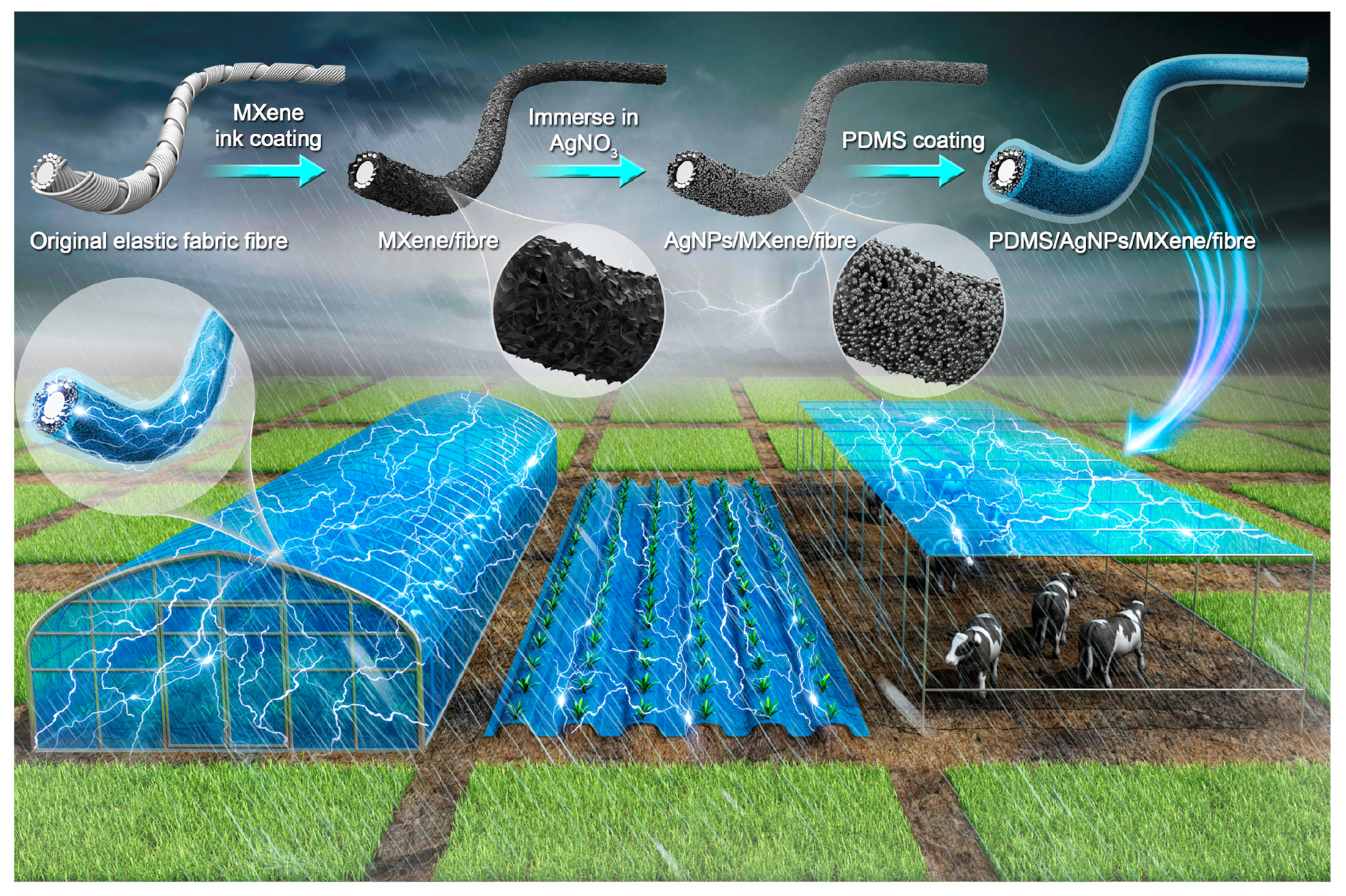
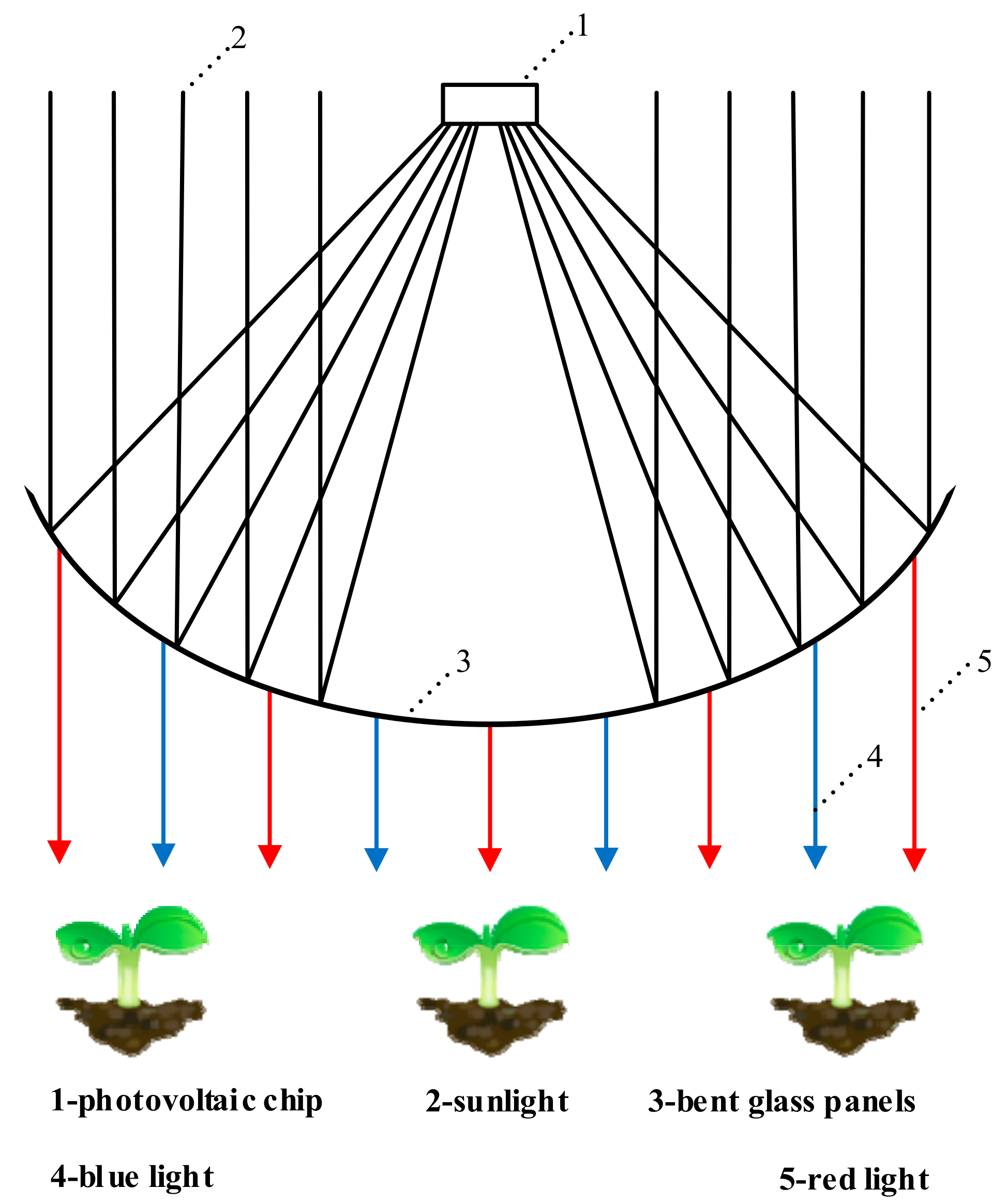
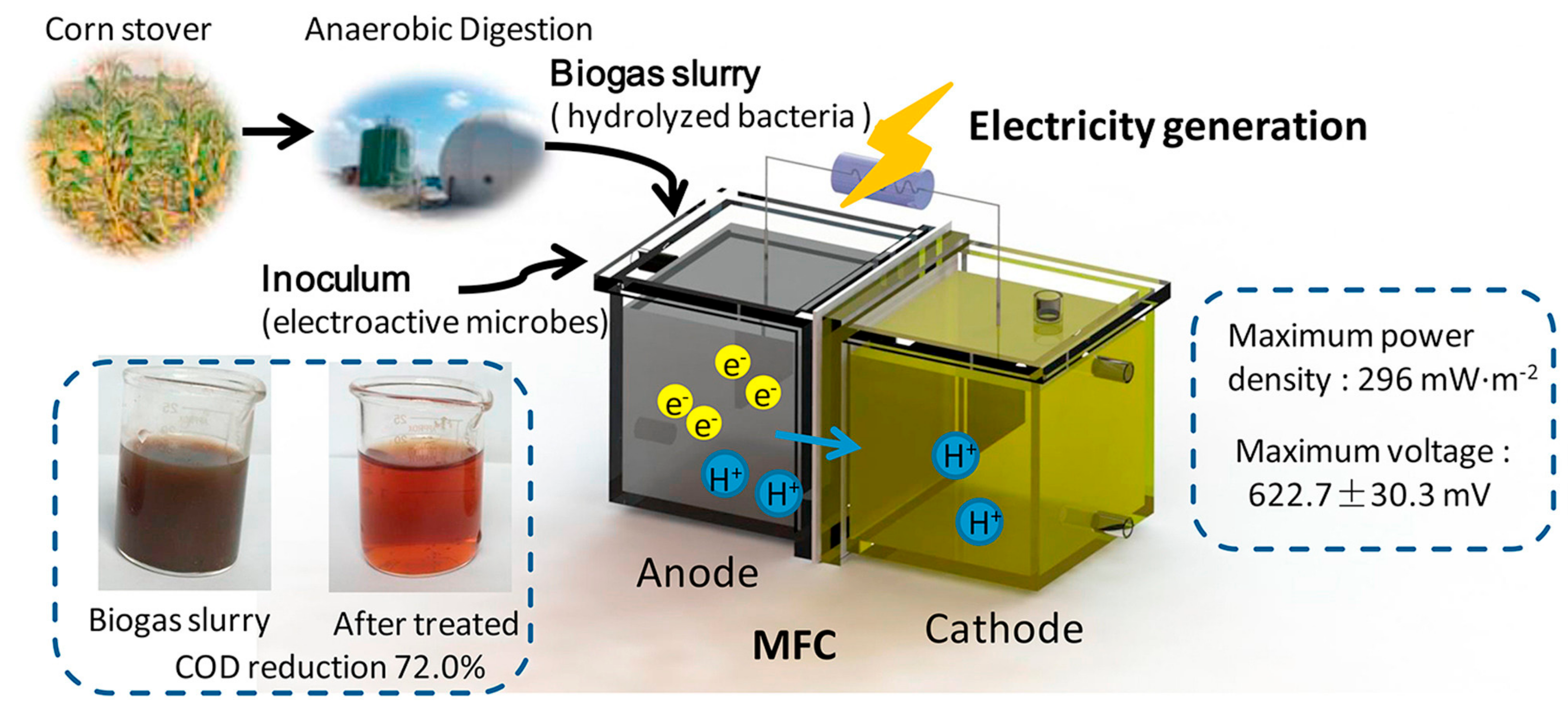
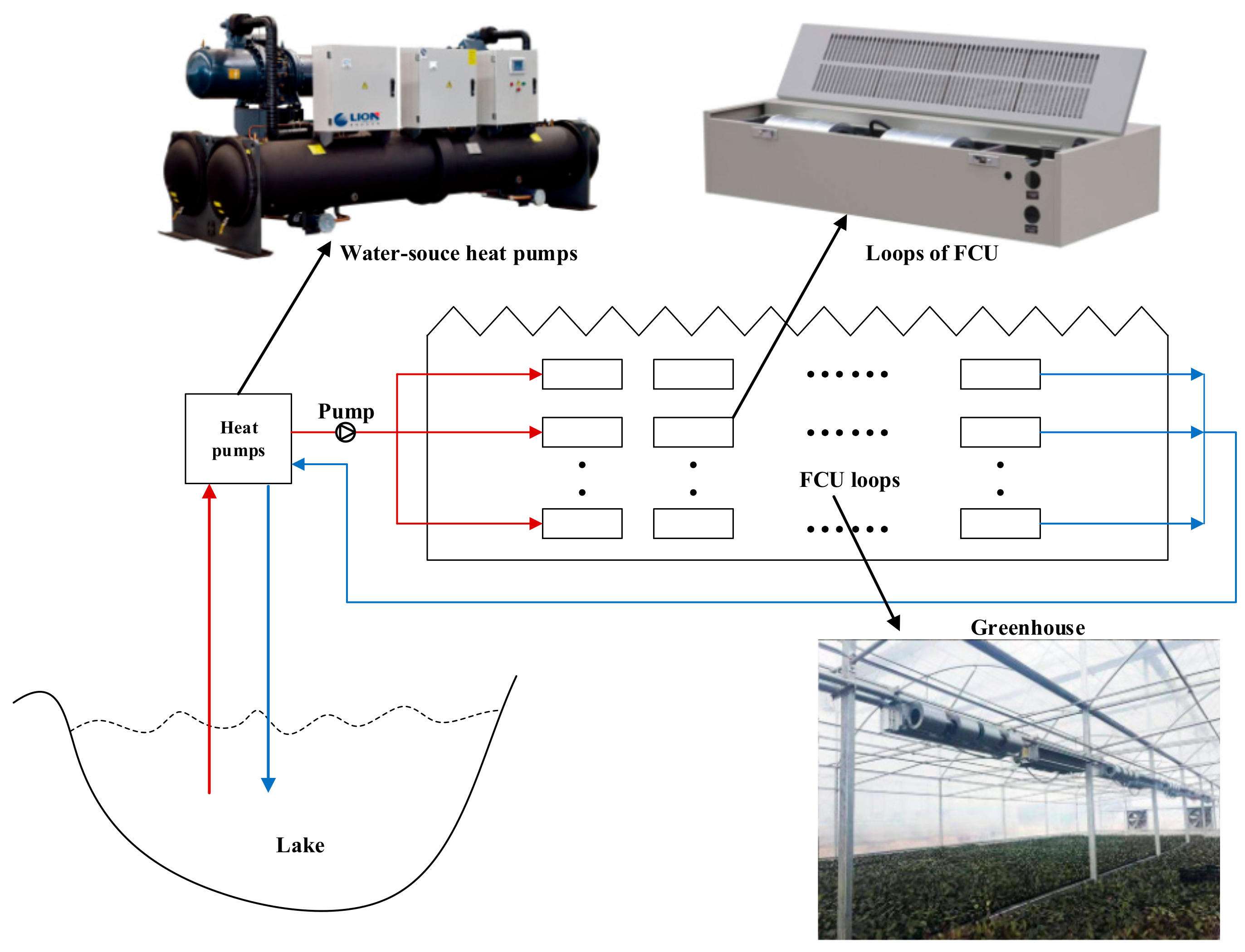
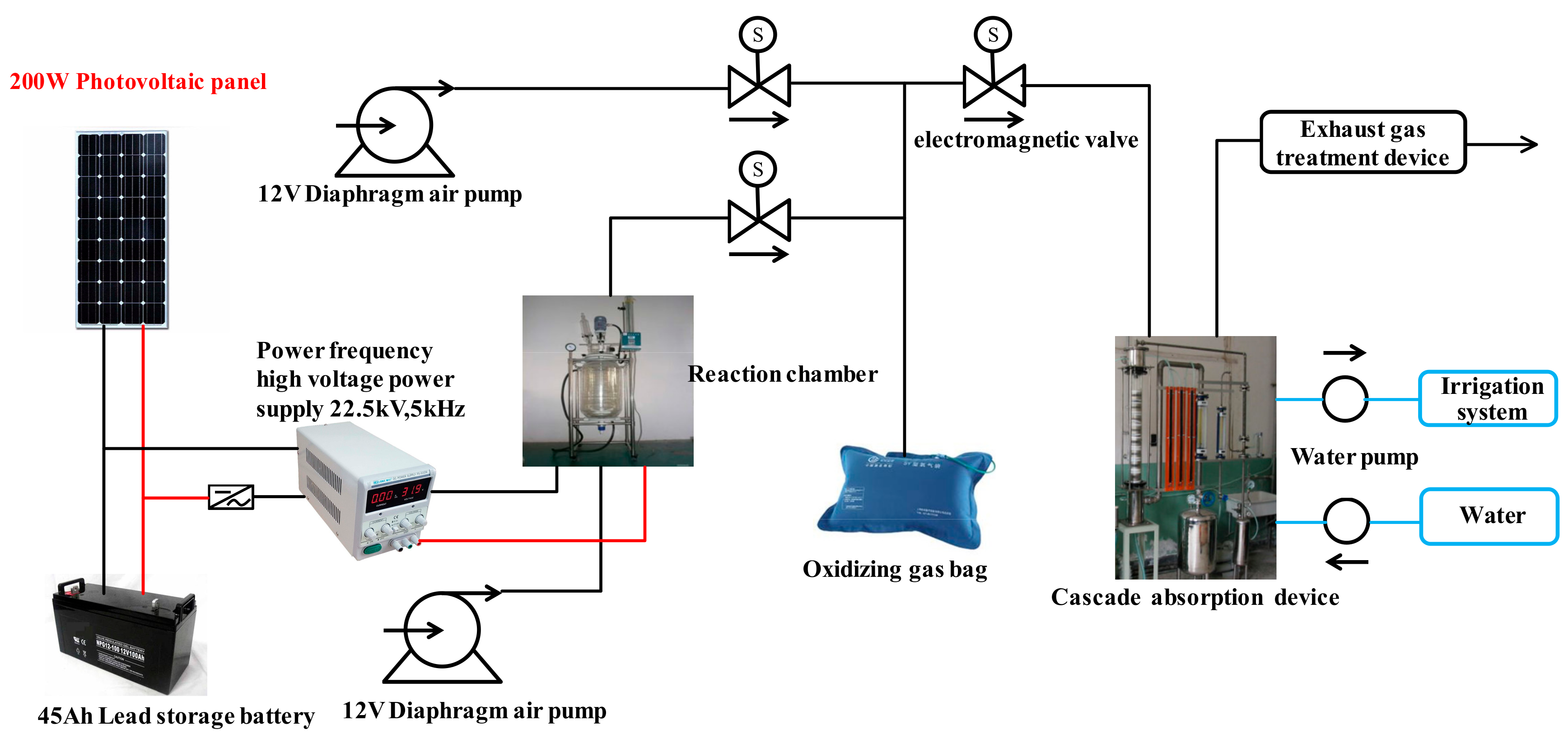
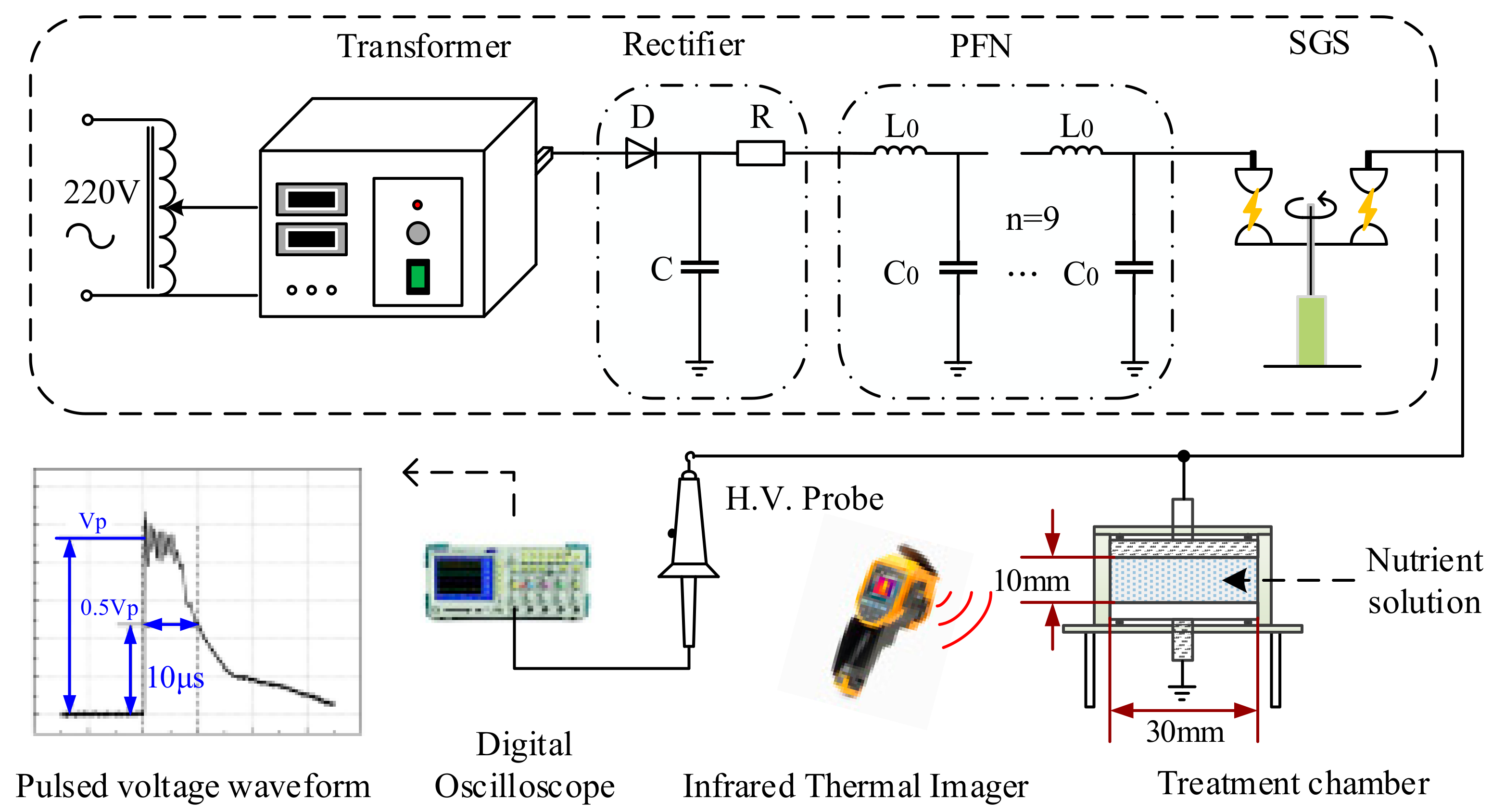
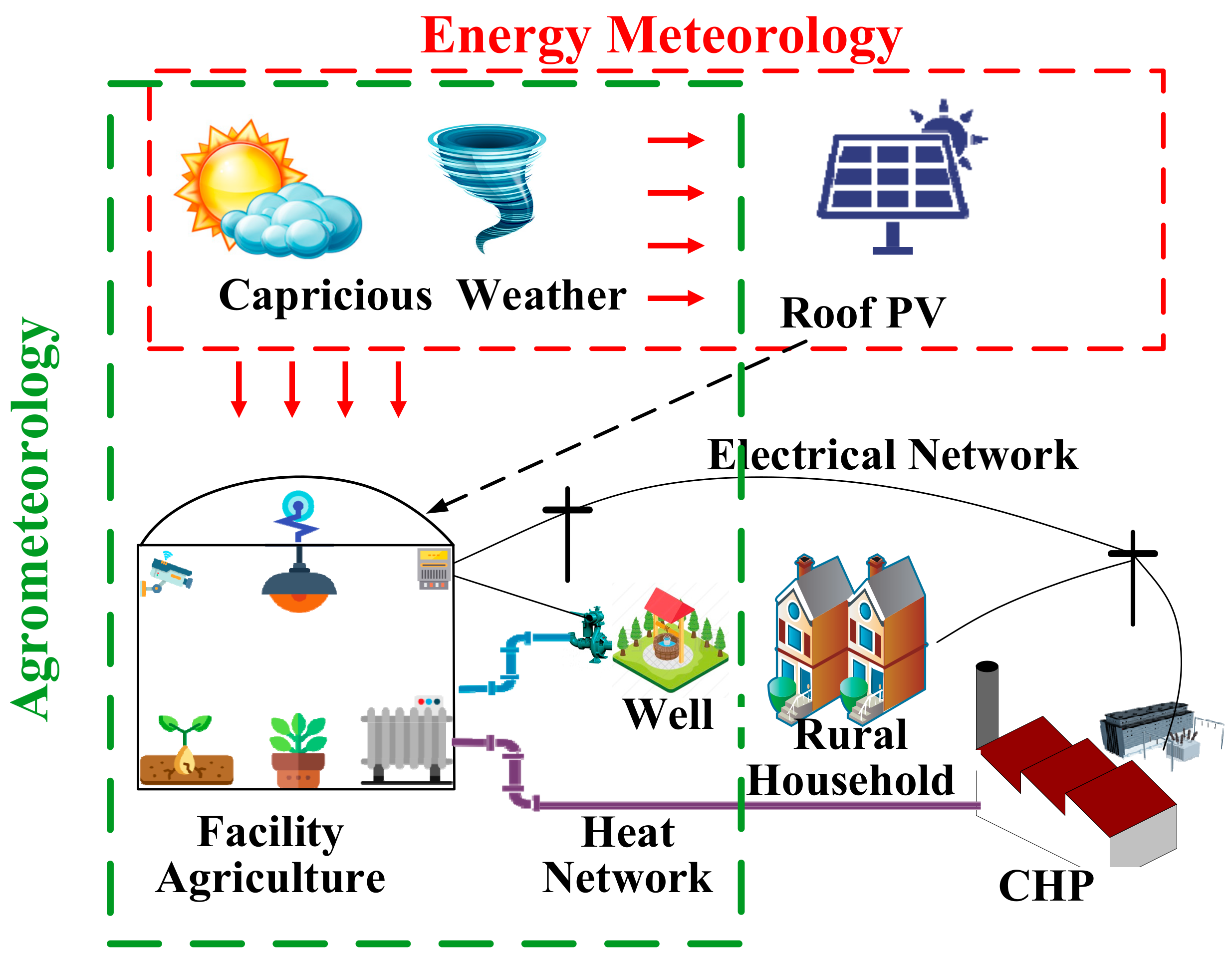
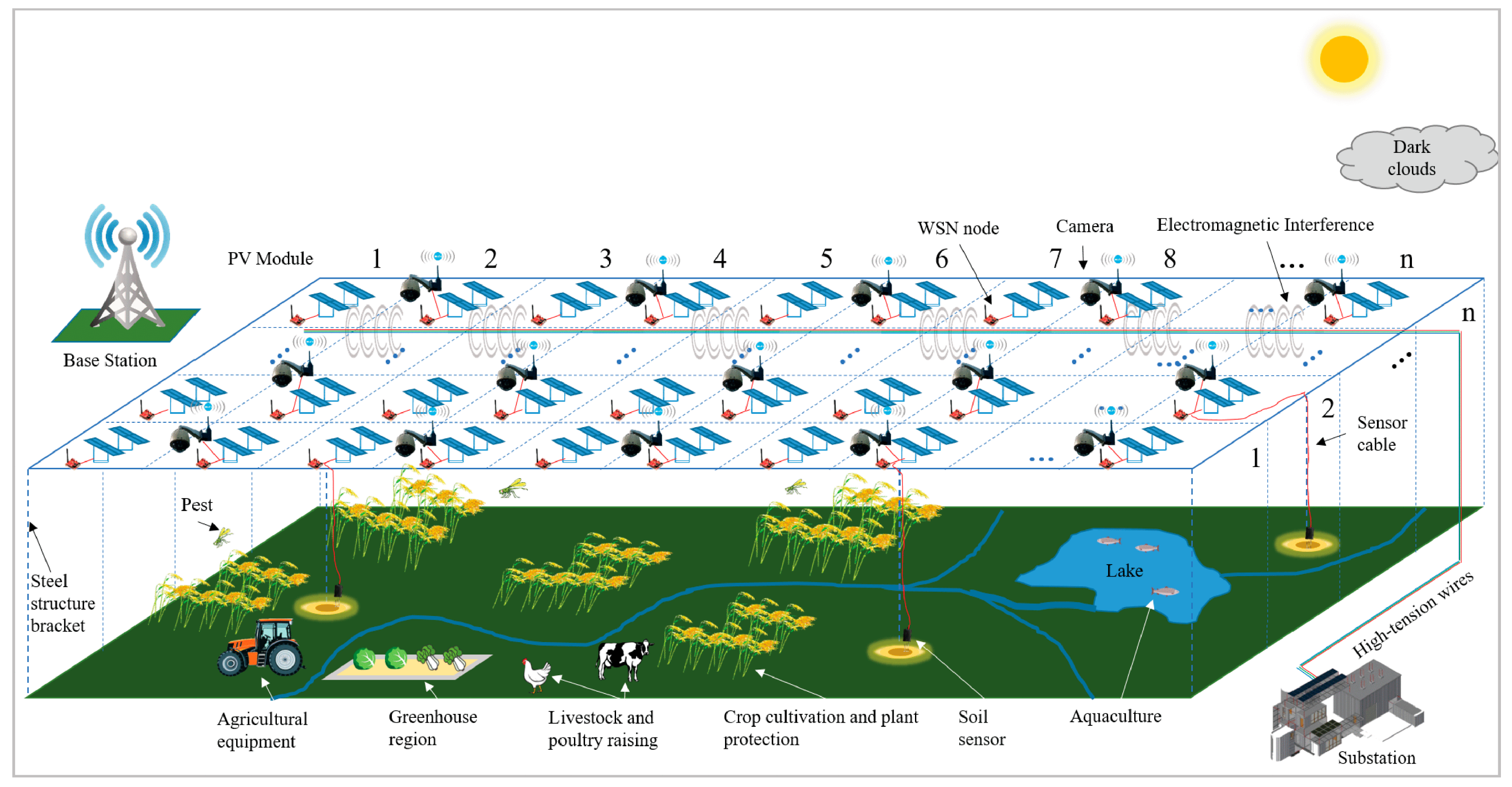
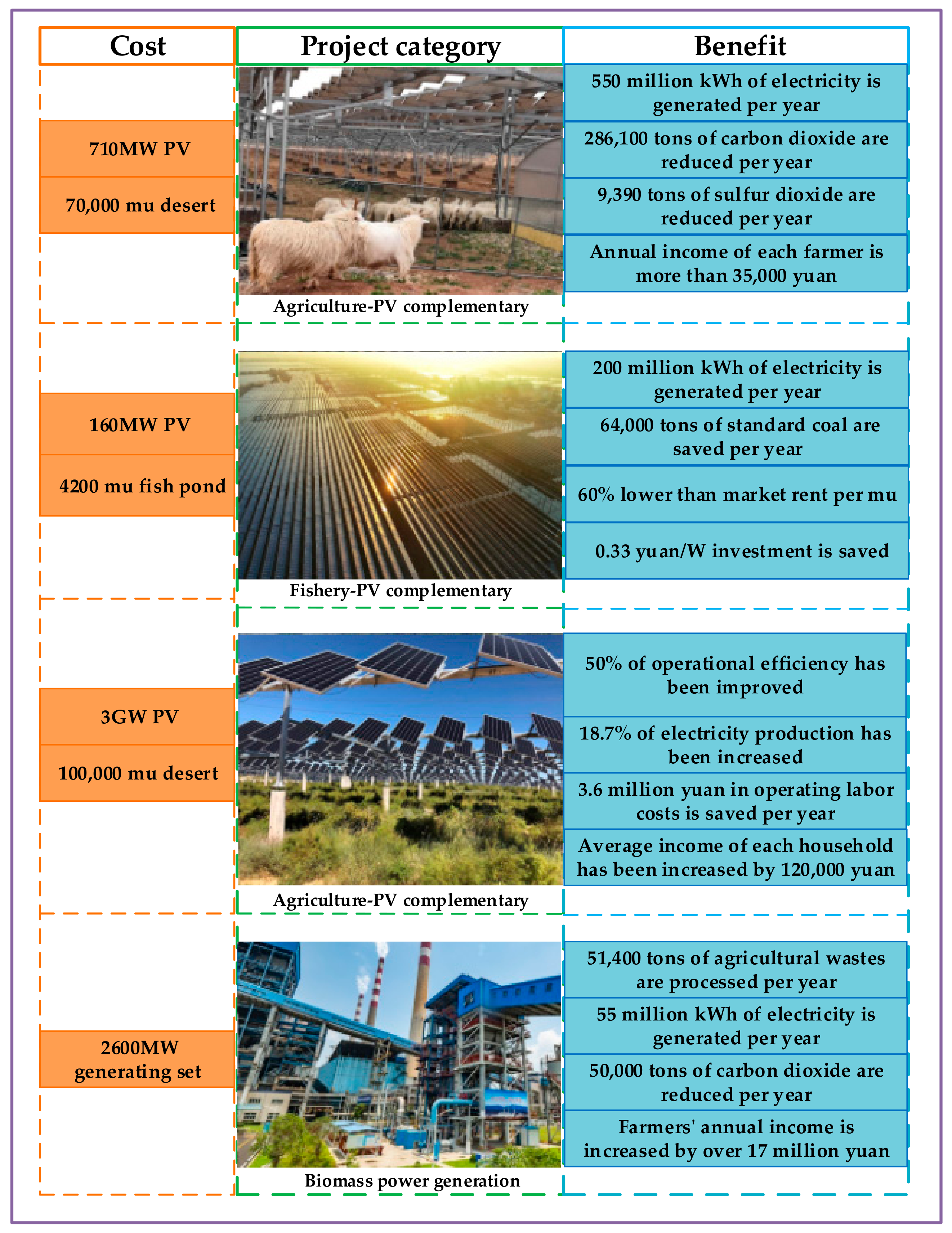
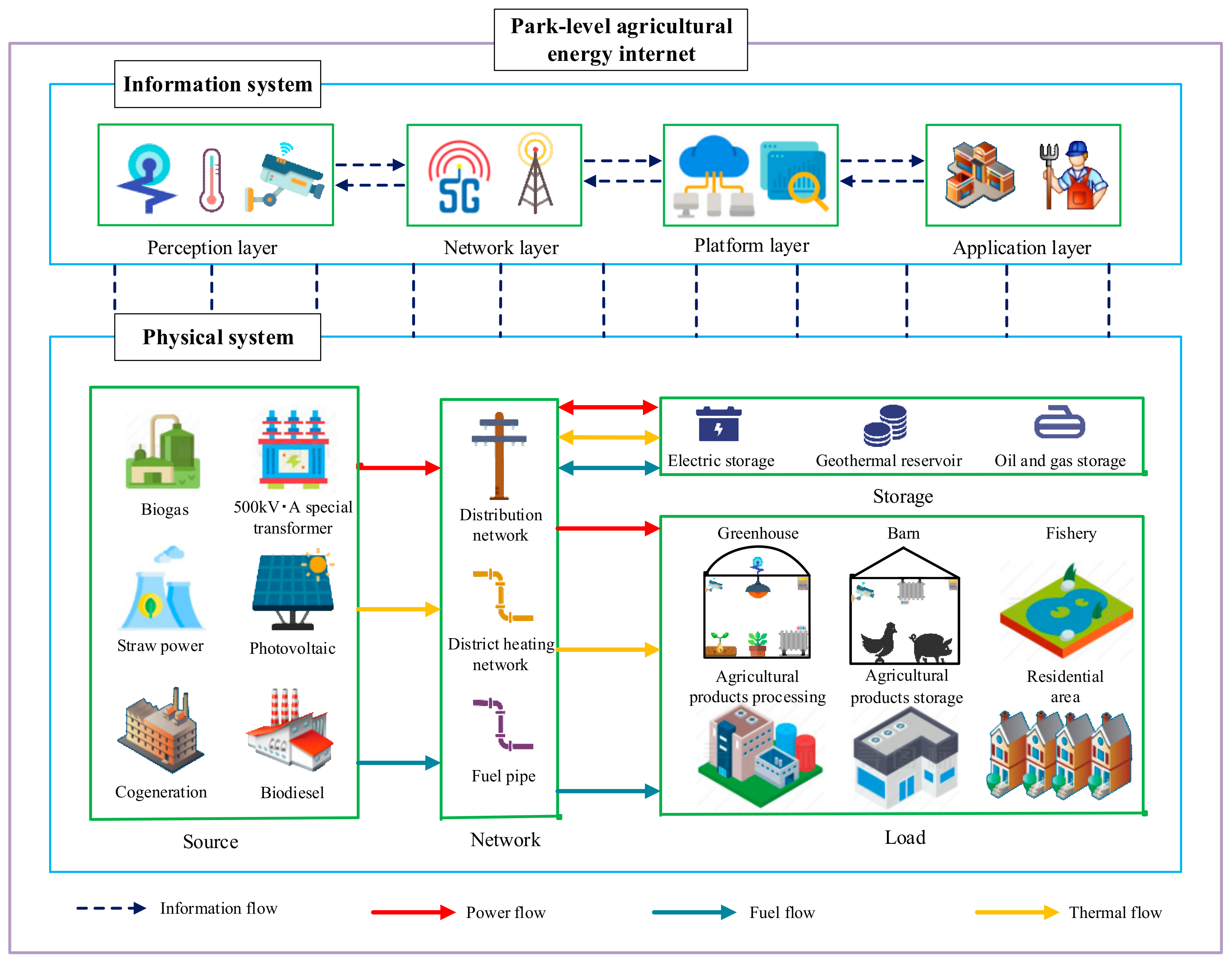
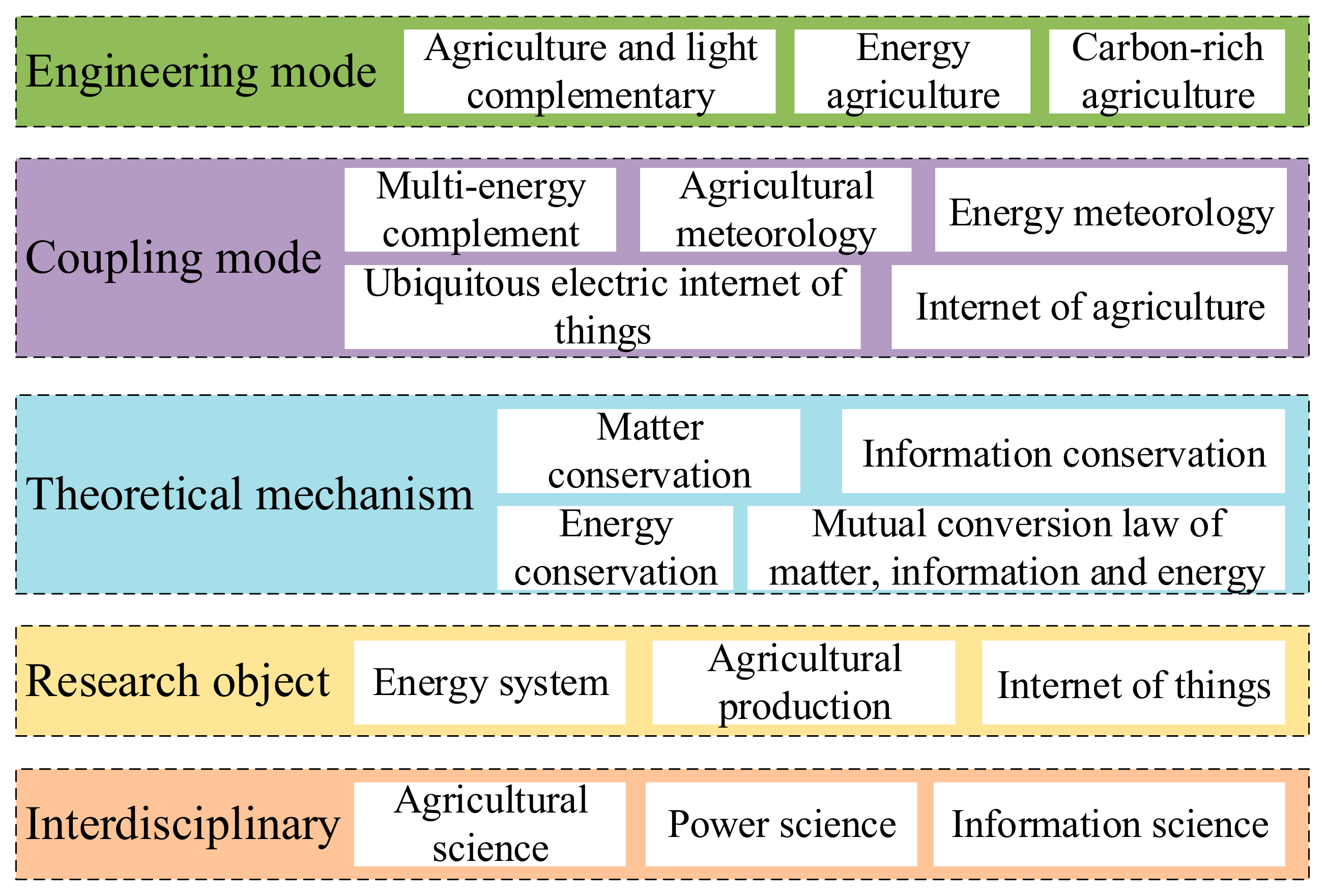
| Category | Technology Name | Core Principle | Benefit |
|---|---|---|---|
| New agricultural energy power generation technology | Agricultural textile power generation technology [124] | Conversion of kinetic energy into electric energy | a. Shading to protect crops b. Provide driving force for smart agriculture |
| Concentrating photovoltaic and diffraction interferometry technology [125] | Diffraction and interference of light | a. Reduce water evaporation b. Improve power generation efficiency | |
| Microbial fuel cell technology [126] | Anaerobic respiration of microorganisms | a. Effectively degrade organic matter in biogas slurry b. Generate electric energy during degradation | |
| Agricultural energy use technology | Greenhouse heating technology based on computational fluid dynamics (CFD) and the energy prediction model (EPM) [68] | CFD | a. Precisely control the environment of facility agriculture b. Reduce energy consumption |
| Solar low temperature plasma nitrogen fixation technology [127] | Photovoltaic nitrogen fixation instead of chemical nitrogen fixation | a. Produce liquid nitrogen fertilizer b. No external energy required | |
| Plant nutrient solution sterilization technology based on the high-voltage pulsed electric field [128] | Physical sterilization instead of chemical sterilization | a. Promote crop growth b. Reduce energy consumption | |
| Technology for analyzing the safety of the agricultural micro-energy network [129] | Agrometeorology and energy meteorology | a. Provide safety warning for facility agricultural environment b. Provide safety warning for energy system | |
| Internet of things (IoT) technology | Photovoltaic agricultural internet of things (PAIoT) technology [130] | Radio frequency identification (RFID), Wireless data communication | a. Monitor agricultural system status b. Monitor energy system status |
Publisher’s Note: MDPI stays neutral with regard to jurisdictional claims in published maps and institutional affiliations. |
© 2021 by the authors. Licensee MDPI, Basel, Switzerland. This article is an open access article distributed under the terms and conditions of the Creative Commons Attribution (CC BY) license (http://creativecommons.org/licenses/by/4.0/).
Share and Cite
Fu, X.; Zhou, Y.; Yang, F.; Ma, L.; Long, H.; Zhong, Y.; Ni, P. A Review of Key Technologies and Trends in the Development of Integrated Heating and Power Systems in Agriculture. Entropy 2021, 23, 260. https://doi.org/10.3390/e23020260
Fu X, Zhou Y, Yang F, Ma L, Long H, Zhong Y, Ni P. A Review of Key Technologies and Trends in the Development of Integrated Heating and Power Systems in Agriculture. Entropy. 2021; 23(2):260. https://doi.org/10.3390/e23020260
Chicago/Turabian StyleFu, Xueqian, Yazhong Zhou, Feifei Yang, Lingxi Ma, Hai Long, Yujie Zhong, and Peng Ni. 2021. "A Review of Key Technologies and Trends in the Development of Integrated Heating and Power Systems in Agriculture" Entropy 23, no. 2: 260. https://doi.org/10.3390/e23020260
APA StyleFu, X., Zhou, Y., Yang, F., Ma, L., Long, H., Zhong, Y., & Ni, P. (2021). A Review of Key Technologies and Trends in the Development of Integrated Heating and Power Systems in Agriculture. Entropy, 23(2), 260. https://doi.org/10.3390/e23020260








